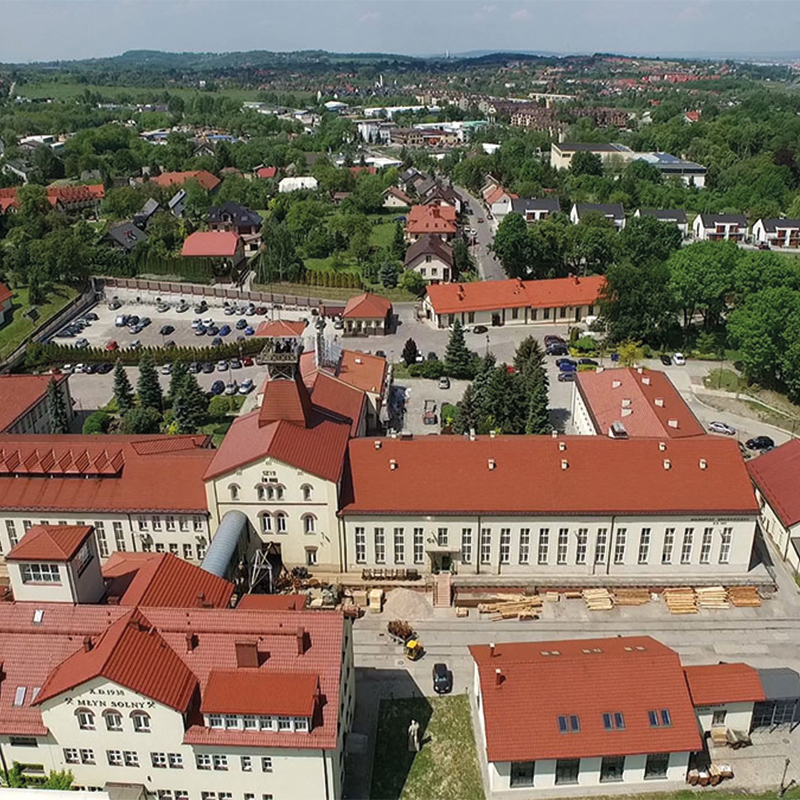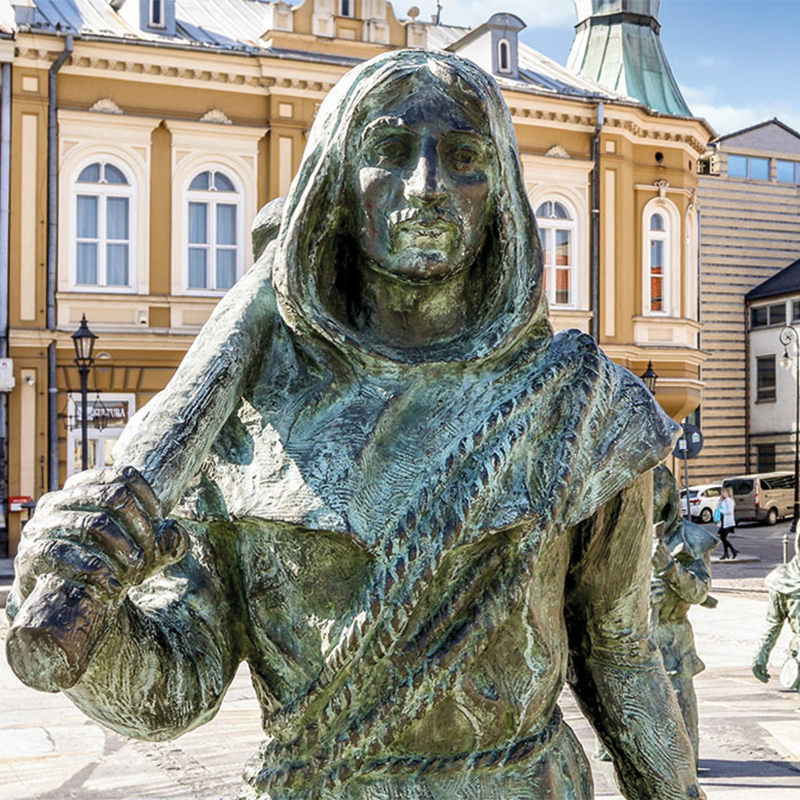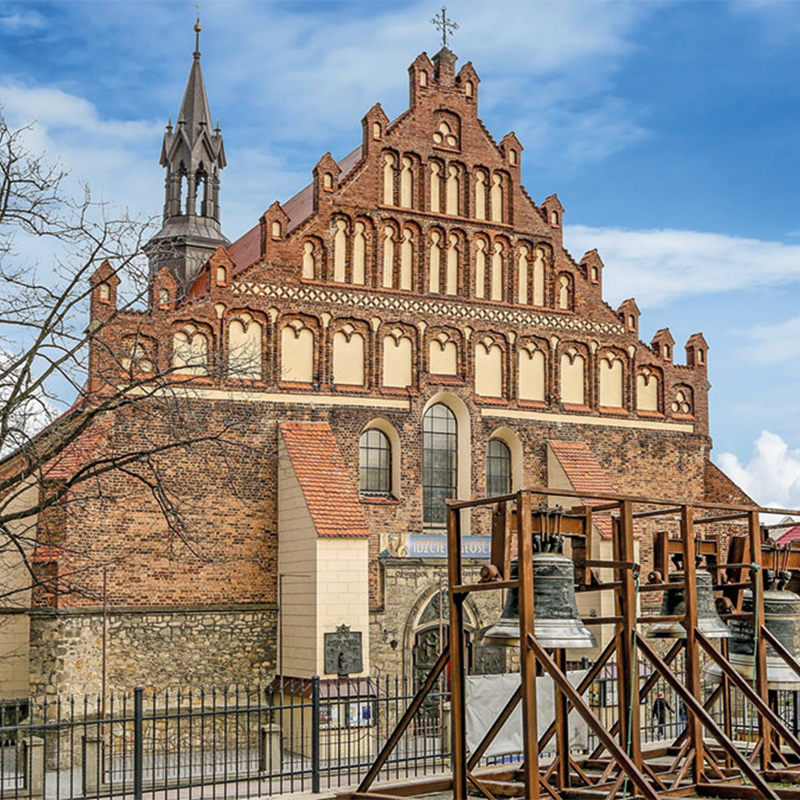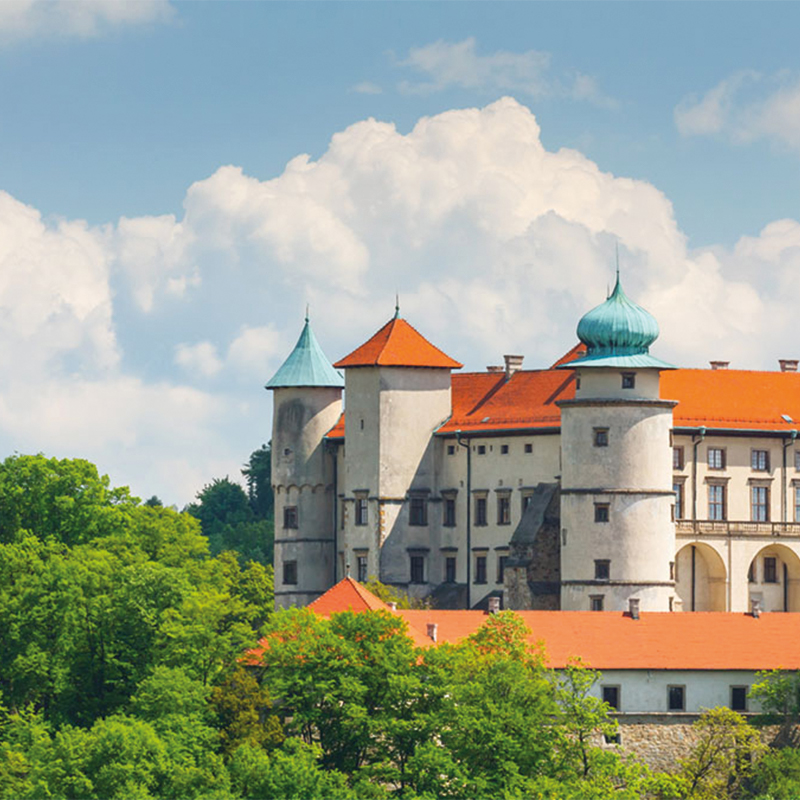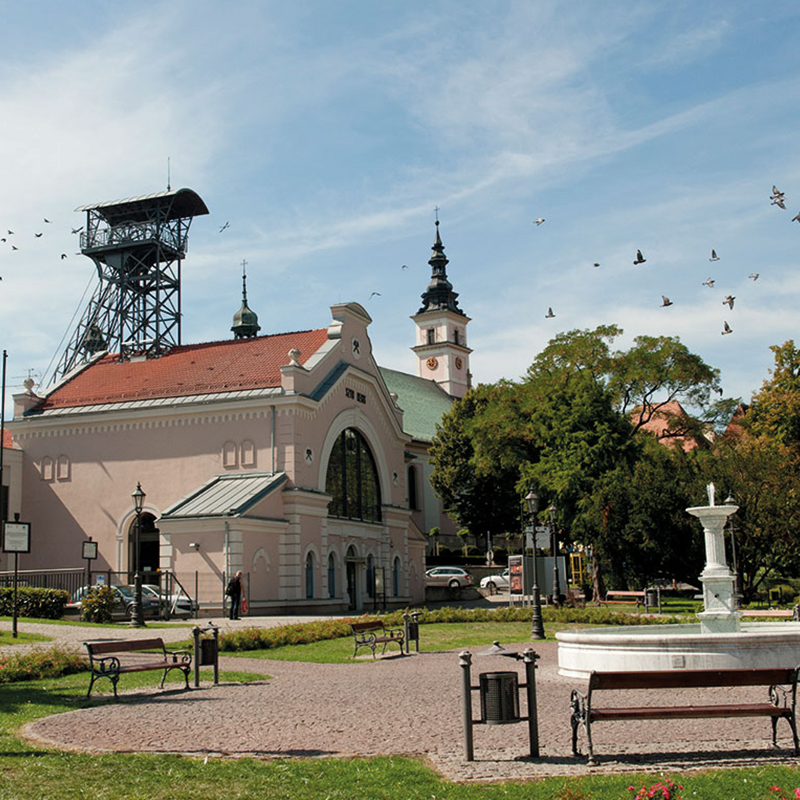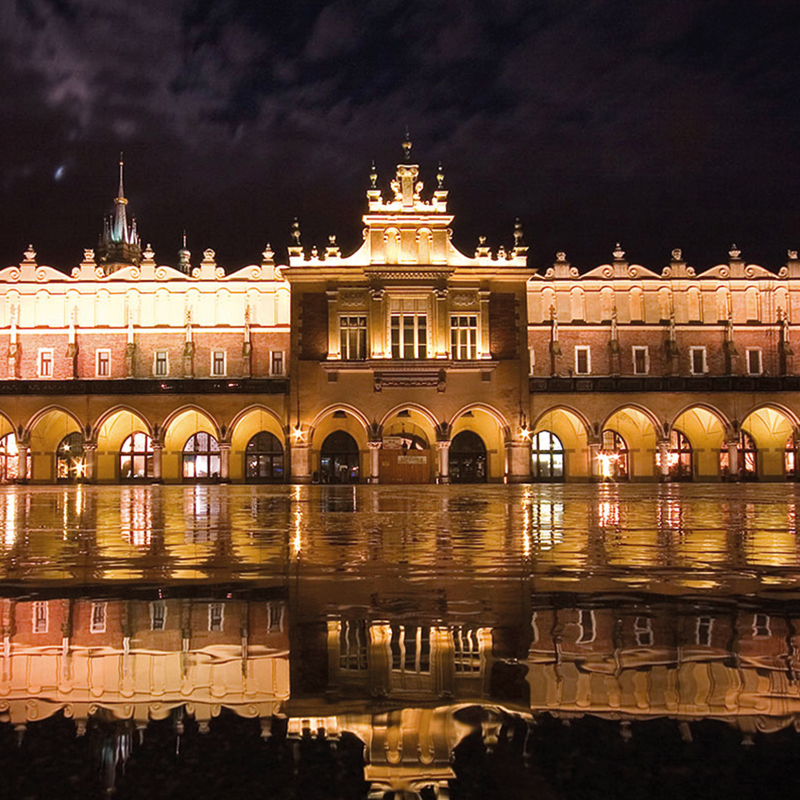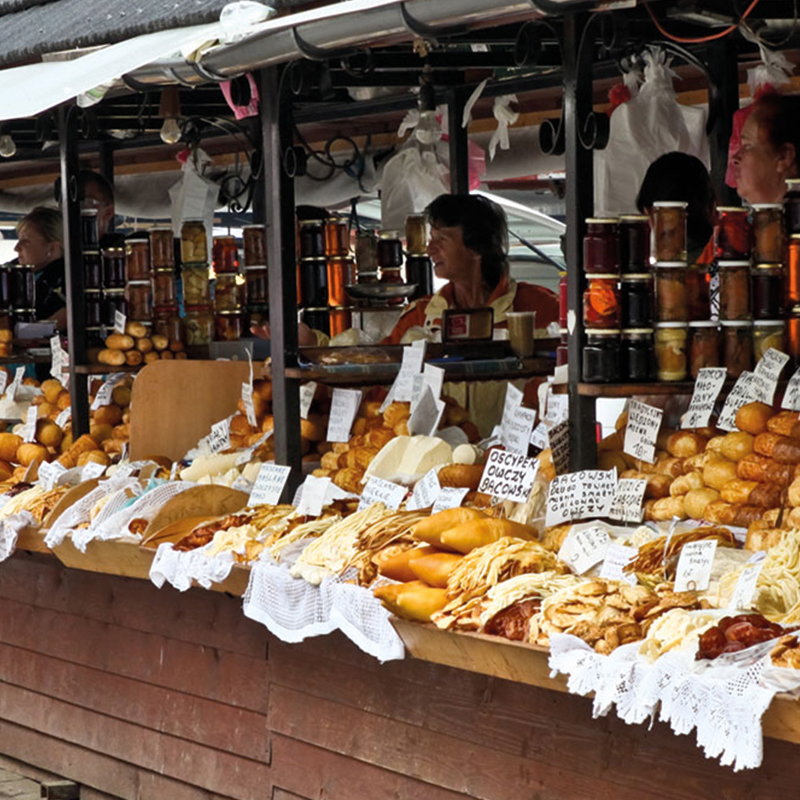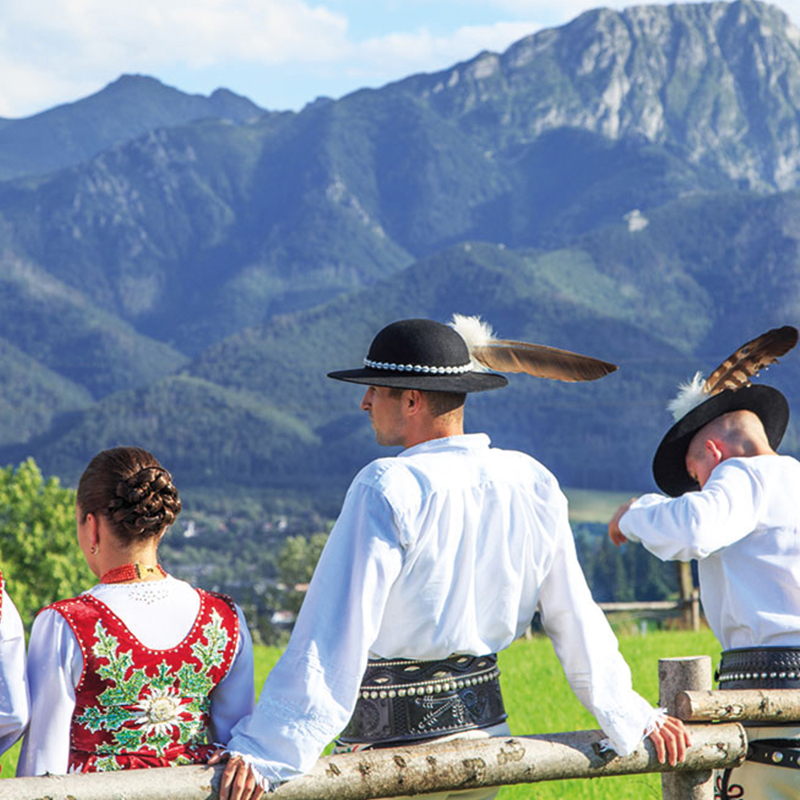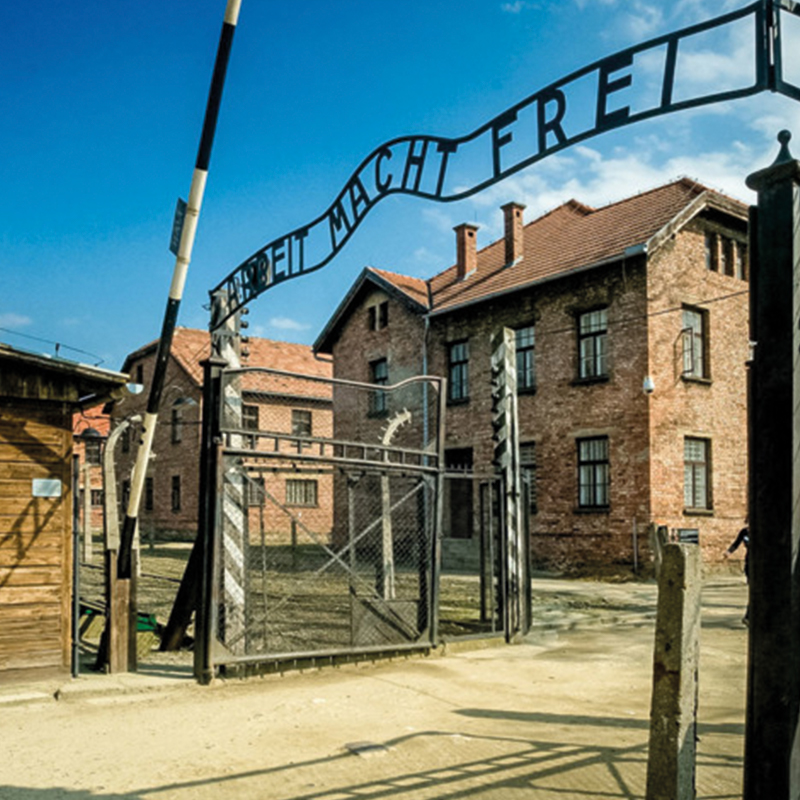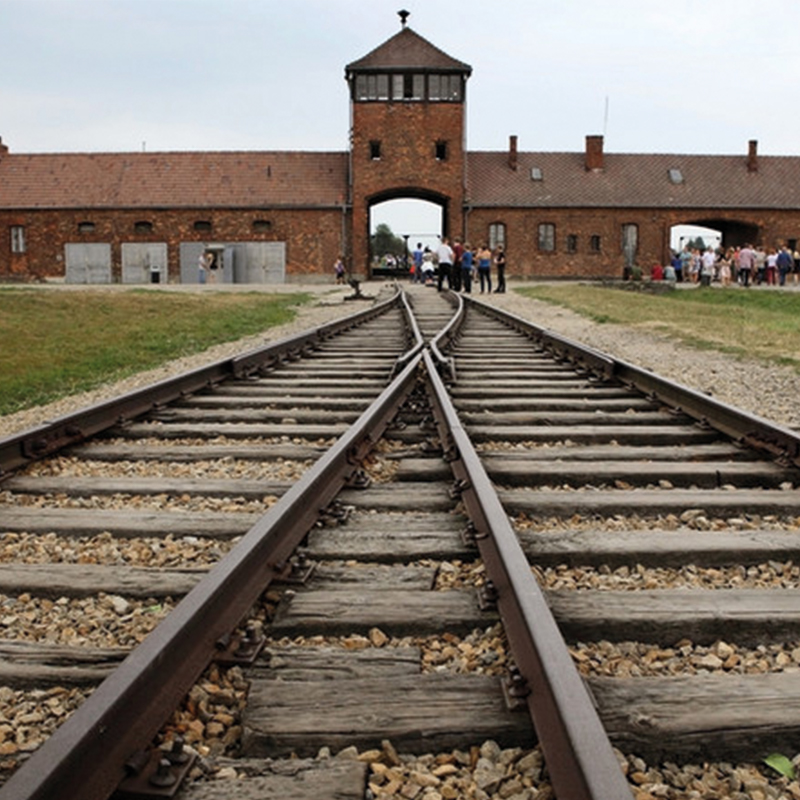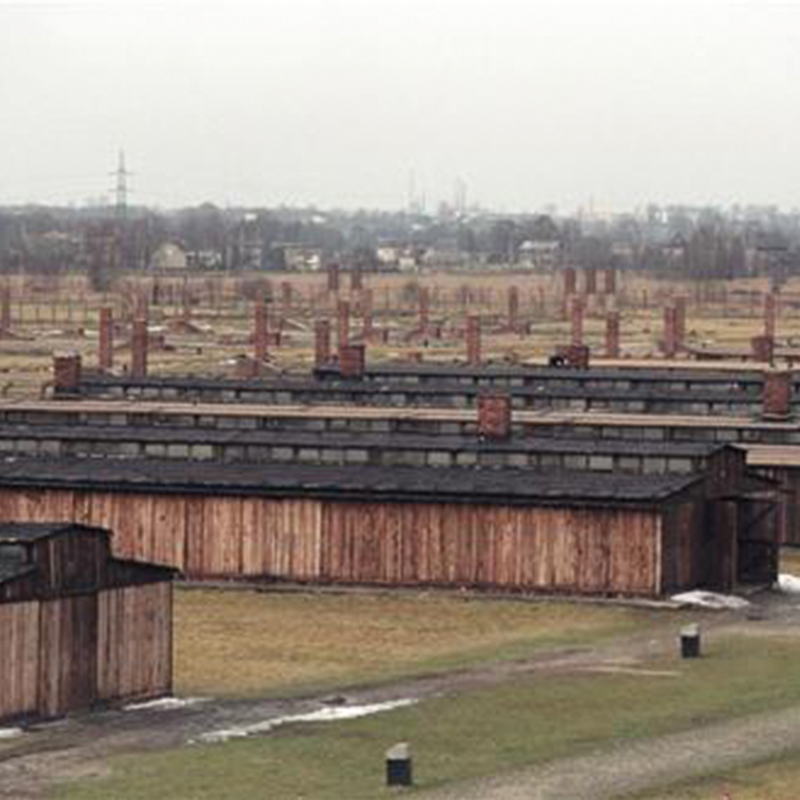About the region
Małopolska is located in the south of Poland and is replete with interesting places where one can spend time in a pleasant and interesting manner. The diversity of this part of Poland encourages tourists to become acquainted with the whole region, yet several places deserve special attention:
WIELICZKA i BOCHNIA
During your stay in Wieliczka, it is worth visiting the town itself, enchantingly located in a valley among hills. Along the way to the Daniłowicz Shaft, the entire complex of the mine buildings can be seen: the Park of St. Kinga, the new impressive Graduation Tower, the former saline baths restored as Hotel Grand Sal, modern saltworks, the Salt Mill and the grand building of the Shaft of St. Kinga. Hoist towers of other shafts are also noticeable in the town’s skyline.
The neo-Baroque Church of St. Clemens, on the other hand, is located right by the Salt Works Castle. It is worth stepping inside on account of the figures of patrons of miners and epitaphs of town residents who have contributed to the development of the Saltworks. Below the Church, you will see the recently-renovated Regis Shaft – the oldest one in the town. The neo-Baroque building dates back to the end of the 19th century, yet the shaft itself was dug as early as the middle of the 14th century. Centuries ago, the town gate was located near it; on the Lower Market merchants traded salt, and commercial trails leading to Cracow, Ruthenia and Greater Poland started in this place. Below the Saltworks Castle, there are two more prominent buildings to see: the neo-Gothic Foreman's Lodge – the former seat of the Saltworks Museum and the Mining School – and the Town Hall. Then, visitors have to go up-hill again in order to see Wieliczka's Upper Market. In the foreground, there is the Przychocki Palace – one of three Wieliczka’s palaces which in the past belonged to families who grew rich from salt trade. On the Market Square, there are figures of four miners, cast in bronze in 2011 and a three-dimensional painting imitating the inside of the mine underground. It is also worth visiting the Monastery of Reformed Franciscans from the 18th century, clearly visible in the town’s panorama.
Bochnia, the second mining town with a salt mine, is also an interesting location. It is one of the oldest towns in Lesser Poland, which received charter already in 1259 and enjoyed affluence for centuries. In the town centre, it is worth visiting the Gothic Basilica of St. Nicolas from the 15th century, and the Chapel of St. Kinga with an interesting altar painting, showing the princess as young and pretty. Tourists should also take a look at the original wooden bell-tower from the 18th century, located right by the Basilica, town houses by the Market Square and the Sutoris Shaft from the 13th century. Nowy Wiśnicz – a place featuring one of the greatest strongholds of the former Republic of Poland – is located 7 km south of Bochnia. The castle was built already in the 14th century and belonged to several Polish magnate families, but it was the Lubomirski Family that made it famous: in the 17th century, it was transformed into a Renaissance and Baroque residence. The Lubomirski family gained their wealth significantly from, among others, trading salt from the Cracow Saltworks. The corner towers, bastion fortifications, courtyards and gardens, a magnificent ballroom and crypt with tombs of the members of the Lubomirski family are quite impressive. The Beskids can be seen from the vantage point. The “Bat's Route” leads through the underground of the stronghold and in the VR Bastion tourists are transported to the past with the use of the state-of-the-art technology.
Wieliczka lies at a distance of only 14 km from Niepołomice – another charming town. The vast forest in the vicinity of Niepołomice for centuries was the favourite hunting ground of the Polish kings. In the 14th century, they erected a hunting palace here and in the 16th century, the second royal residence (right after Wawel) was built here. It is open to visitors; attention should be paid to the Renaissance courtyard, gardens and an exhibition of hunting trophies. On a sunny day, it is also a good idea to go for a walk to the Niepołomice Forest. It is a beautiful, mixed forest with a number of protected plant and fungi species. There are also deer, roe deer and wild boars, but the king of the forest is the European bison – the largest mammal in Europe. The Bison Breeding Centre has been operating in the heart of the forest for almost 100 years. The Centre is involved in activities aimed at protecting this animal threatened with extinction. Bison headcount around the world is approx. 5,000 and 30 animals live in the Niepołomice Forest. It is possible to observe them from a special tower, yet only after procuring the permit of the local forest inspectorate
CRACOW
Cracow occupies a special place in the history, culture and spirituality of Poles. From the beginning of the 11th century until the end of the 18th century it served as the capital of Poland, a treasure trove of national tokens and symbols. Nowadays, it is a European city, open and teeming with life. The Cracow agglomeration has approx. 1.4 million residents. Its historic centre was entered in the first UNESCO list in 1978.
It is possible to see Cracow during a trip organised by the ICMUM 2018 conference organisers or on your own. The most important monuments that should not be missed include: the Royal Wawel Castle, the Main Market Square with St. Mary’s Church and the Cloth Hall, the former university district with Collegium Maius, Medieval city fortifications and the former Jewish district of Kazimierz. Cracow is one of the cities in the Central Europe which has the most abundant museum collections. In the National Museum, tourists can see the famous painting by Leonardo da Vinci, “Lady with an Ermine.” Cracow is the home town of many museums, former and modern art galleries, archaeological, historical, ethnographic, university, church, military and technical museums. In order to see the former interiors of town houses and palaces in the vicinity of the Main Market Square, it is worth stepping into Jan Matejko’s House at ul. Floriańska, the Hippolit House at St. Mary's Square or the Palace of Bishop Erasm Ciołek at ul. Kanonicza. Persons who are particularly interested in the history of the Polish Jews should visit, apart from the Kazimierz District, the museum in the former “Emalia” Factory of Oscar Schindler, and go to the premises of the former Nazi German labour and concentration camp called “Płaszów” in the Podgórze District. The camp operated in this place between 1943 and 1945; approx. 150,000 Jewish people were transferred here from Cracow’s ghetto and brought from Slovakia and Hungary. On the other hand, tourists interested in the socialist realist architecture and the communism period in Cracow should go to the Nowa Huta District. The Cracow's mounds are quite unique – located in various parts of the city, which were erected in these areas since the pre-historical times. The most interesting one, offering best views, is the Kościuszko Mound. It was built on Sikornik Hill in 1823 as an expression of homage for Tadeusz Kościuszko – the national hero of Poland and the United States. It is possible to reach it walking from the Salwator district along the Aleja Waszyngtona (Waszyngton Alley) among beautiful villas and old trees. Right by the mound, there is an impressive citadel fort from the 19th century; after purchasing the ticket, tourists can also climb to the top of the mound where there is a panorama of Cracow, surrounding villages and mountains in the south – the Beskids and the Tatra Mountains, lying at a distance of 100 km. Whilst in Cracow, it is also a good idea to go on a cruise along the Vistula. The cruise lasts for half an hour in the area of the city centre. If you choose the longer cruise, you will have a chance to see the Camaldolese Monastery in Bielany from the 17th century and the vineyard located next to it, as well as the Benedictine Abbey in Tyniec, ending the cruise, picturesquely located on a limestone hill. This is the oldest operating monastery in Poland; itsbeginnings date back to the 11th century. At the present moment, it is open both for pilgrims and tourists. Apart from visiting the museum and the church, you can also have a bite to eat and purchase some specialities produced by the monks: herbs, preserves and beverages (beer, tinctures and meads).
Cracow is also greatly attractive in the evenings and at night-time. Tourists can savour delicacies of the Polish and international cuisine in numerous restaurants. Dozens of clubs, pubs and wineries are located in the vicinity of the Main Market Square and around Kazimierz. In many of them you can dance, listen to live music and meet people from all over the world. With respect to night-time entertainment, Cracow has been well-known around Europe for a number of years. Even an evening walk or a ride in a Melex-car in the old city centre, illuminated by the lanterns, is an unforgettable experience.
THE TATRA MOUNTAINS AND ZAKOPANE
The Tatra Mountains, the highest and the most beautiful Polish mountains, lie at a distance of 100 km from Cracow and Wieliczka. Even the road that leads to Zakopane, namely the so-called “Zakopianka”, offers magnificent views. You can go to Zakopane by car, train or by bus from Cracow. The connections are very frequent and the ride lasts 2 - 2.30 hours, depending on the traffic jam and difficulties on road (construction of highway).
The Tatras are alpine mountains; they are a part of the Carpathian Mountains and since 1955 have been protected as a National Park. The Polish and Slovakian border runs along the mountain ridge. In November, the weather in the Tatras may be like in autumn (beautiful colours of the forests to be admired in lower parts of the mountains) or like in winter, with a thick layer of snow and difficult conditions in the mountains. For persons who feel like going on an easy 1 - 2-hour mountain walk, the sub-alpine forest valleys, which are accessible from Zakopane, are recommended: Dolina Białego Potoku (White Creek Valley) and Dolina Strążyska (Stążyska Valley). If you have 4-5 hours at your disposal, you can go to Kościeliska Valley or Chochołowska Valley. Following convenient and almost flat paths, you can stroll among muttering brooks, rocky spires and gates and reach cosy mountain refuges offering snacks and refreshment. You can also see traces of mining here: in the past, iron, copper and silver ore were mined, along with raw rock materials and even uranium. The flagship destination of easy trips is Morskie Oko in the High Tatras – a beautiful mountain lake surrounded by a wall of granite peaks. You can reach it via an asphalt road (8 km one way) or take a horse-drawn carriage; the whole trip takes up one day. When you reach your destination, unforgettable sights and a cosy mountain shelter with tasty food will greet you. If you feel like going on a true mountain hike, you can visit the ridge of the Western Tatras, Mount Giewont or Dolina Pięciu Stawów Polskich (Valley of the Five Polish Lakes). In the last valley, you can see five lakes, and along the way – the highest Polish waterfall, Siklawa (70 metres high). Trails in the High Tatras are intended for ambitious and experienced climbers; you can climb the highest Polish peak, Rysy (2,499 metres above sea level) or try your skills at the so-called “Orla Perć.” However, these trails are very demanding (chains, ladders, precipices and breath-taking views). Do not venture there when the weather is bad or in winter. Tourist trails in the Tatras are well-marked and you can also buy detailed maps in many spots in Zakopane.
The Tatras are not vast, but they captivate with the beauty of nature. In the mountains, you can also meet several animals: chamois, deer, roe deer, foxes, wolves, owls, squirrels and hedgehogs. It is also possible to spot a marmot among the rocks and an eagle in the sky. There is also a chance of a face to face meeting with a bear.
For persons who want to reach the ridge of the Tatras comfortably and quickly, a modern cable car from Zakopane (Kuźnice) to Kasprowy Wierch is recommended. It is open all year round and it transports tourists and skiers to the height of 1,960 metres. Kasprowy Wierch is the starting point for hiking trails leading west – to the lower Western Tatras, east – to the High Tatras, as well as skiing routes to valleys on the Polish side of the Tatras.
The Tatra Mountains not only offer mountain climbing, skiing and snowboard. Various sports can be practised in immediate vicinity of the mountains. There are running trails, bike and off-road paths, rope parks, paint ball venues, horseback riding paths, tennis courts, shooting ranges and sports stadiums. You can also try zorbing, downhill mountain biking, bungie-jumping, as well as fly over the mountains with an instructor on a powered hang-glider. In winter, you can try ski-touring, snow safari on a quad and scooter, skating on one of several skating rinks or a romantic ride in a horse-drawn sledge.
Zakopane, known as the “winter capital of Poland”, lies at the foot of the Tatras. Only three centuries ago, it was just a little settlement in impassable forests. Its residents were Poles and Vlachs – shepherds who came from the Balkan area and who brought their distinct culture and folklore. In the 18th century, naturalists, geologists and first admirers of the mountains started to come here. In the 19th century, Zakopane and the mountain region become fashionable among the upper class and bohemians. The political, artistic and social life flourished here. The first pensions were built and skiers and climbers explored the mountains. At the turn of the 20th century, Zakopane was already a popular health resort, even if still quite low-key. Mass tourism reached the town after World War II and has been dominant to this day. This town of almost 30,000 permanent residents sometimes accommodates thrice this number of people (in November there is “low” season). In Zakopane, you can find both a cosy room in a cottage or a five-star, luxury hotel-resort-spa.
Sightseeing in Zakopane should start from the most famous pedestrian zone in Poland – Krupówki. Down the street, you will find an outdoor market, where you can buy souvenirs and local specialities. You may choose from sheepskin coats, highlander slippers, sheep wool sweaters, flowery scarves, mead, preserves and the Zakopane classics: smoked ewe's milk cheese – “oscypek” and shepherd’s wooden axe – “ciupaga”, a symbol of the Tatra highland robbers. It is quite likely that you will hear local highland dialect and music from loudspeakers – an intriguing mixture of folk and disco. The lower station of the rail car to Gubałówka (1,120 metres above sea level) is located behind the outdoor market. From the Gubałówka vantage points, you can admire the beautiful panorama of the Tatras. On Gubałówka, you can stroll, take a ride on a gravitational slide, buy local souvenirs or visit an inn (highlander style restaurant).
And if you want to explore further, continue your walk up the street. If you are interested in shopping – this is the place for you. You may be dazzled by the accumulation of shops, stalls, restaurants, bakeries and pubs. Any piece of clothing is within your reach – from regional costumes and sportswear to clothes designed by world-famous couturiers. What is more, in the international crowd you may spot portraitists and performers. You may also ride in a horse-drawn carriage. If you continue go further up, you will get to the “Wielka Krokiew” (The Great Rafter) ski jump, beautifully fitted into the slope. Every year in January, World Cup ski jumping competitions are held here, attracting tens of thousands of viewers. The road is lined by stylish guest houses and mountaineer inns. If hungry, you must try the cuisine of the mountain region: the sauerkraut kwaśnica soup from a cauldron, the shashlik or the highlander's potato pancake with spicy goulash, cheese and sour cream.
In Zakopane, you can admire the original, traditional architecture, not encountered anywhere else. At the meeting point of Krupówki and the market, turn into Kościeliska Street to see cottages of the oldest highlander families. Nowadays, they are important monuments. First, you will see the first church in Zakopane, dating back to the middle of the 19th century, enchanting by its simplicity. Right next to it is the Cemetery in Pęksowy Brzyzek, the burial site of the founders of the legend of Zakopane: activists, artists, great sportsmen and mountain guides. Their gravestones, made of wood and pebbles, are unique. Afterwards, you can stop by the oldest inn in Zakopane, “U wnuka” (the Grandson’s restaurant), opened 170 years ago, and then “Koleba” Villa, which is no longer a cottage, but the first house constructed in the Zakopane style. The style was created by the Polish artist Stanisław Witkiewicz. It is a mixture of the traditional mountain-region architecture and pension villas from the Alps. In Zakopane, many exquisite buildings were erected in this style and you should definitely see them: the Jaszczurówka Chapel, Pod Jedlami Villa and Witkiewiczówka Villa. The modern architecture of restaurants, and even big hotels, is also influenced by this style.
Zakopane is also full of interesting museums. It is worth visiting the Tatra Museum in Krupówki. You will have a chance to see the original mountaineers’ and robbers’ costumes, interior design of highland cottages, and an exhibition devoted to geology, fauna and flora of the Tatra Mountains. If you are interested in art, Zakopane is full of galleries and artists’ workshops. And if you happen to be fond of the highlander folklore, you can get to know it through festivals, concerts and displays of old handicraft, which are frequently organised in Zakopane. Almost every inn offers original live highlander music in the evenings. You will be impressed by the highland-style dance, which, just like the mountains, is very spontaneous.
Zakopane is also a health resort, with several hospitals, sanatoriums and spas. In Zakopane and the neighbouring area, there are several thermal pools, open all year round, where you can completely relax and regenerate: Aquapark Zakopane, Termy in Chochołów, Termy Bania in Białka Tatrzańska, Termy Bukovina in Bukowina Tatrzańska, Gorący Potok complex in Szaflary. All these facilities feature pools, fountains, artificial rivers, impressive slides, water massage and geysers, saunas and separate relaxation areas.
A visit to Zakopane, combined with a trip to mountains, is going to be an unforgettable experience for you
AUSCHWITZ-BIRKENAU – Former German Nazi Concentration and Extermintion Camp
From Wieliczka and Cracow, you can get the fastest to Oświęcim by car, by taking the A-4 motorway, from which you should turn to national road 933. The Museum is located by this road, on the outskirts of the city. You can also get there by train, bus or a small bus from Cracow.
The Museum consists of two camps: Auschwitz I and Auschwitz II-Birkenau. To acquaint yourself adequately with the place, it is necessary to visit both its parts. In November, the Museum is open from 7.30 am to 3 pm, and time allotted for the visit should be at least three hours. The camps are at the distance of 3.5 km from each other. This span can be covered on foot, by car, by cab or by a museum bus, which runs every 30 minutes in November. Admission to the Auschwitz-Birkenau Memorial is free of charge. You may do sightseeing on your own or in organised guided groups. It is worth booking entrance cards or a guide on the website: www.auschwitz.org (Museum Internet Website).
It is hard to rank Auschwitz-Birkenau among tourist attractions. It is rather an experience. A deep experience of humanity and a lack of it.
AUSCHWITZ I – it was the first concentration camp built by Germans on the territory of the Republic of Poland, seized in September 1939 and incorporated directly into the Reich. The reason for establishing of the camp was overcrowding of German prisons with Poles, arrested after outbreak of World War II for participation in the resistance movement or in street roundups. Germans considered for a few months whether to create the camp here – the terrain in the fork between the rivers Vistula and Soła was quite secluded. Simultaneously, train and road connections leading to the Reich run through there, and on the spot there already were Polish Army barracks pre-dating the war. In April 1940, a decision was made: the terrain was captured by SS (Schutzstaffel) forces, and Obersturmbannführer Rudolf Hess (1940-1943) became the first commandant of the camp. The camp was organised in 22 brick buildings, quickly joined by eight others built by the prisoners. The terrain was surrounded with rows of electrified barbed wire and guardhouses, and people from the entire neighbourhood of the camp were evicted. The first transport of Polish prisoners from Tarnów arrived here on 14th June 1940. In the initial period of the camp’s operation, mainly Poles were detained here: those fighting the occupant, the intelligentsia, priests, people taken prisoners during street roundups, and later also German criminals and homosexuals. The number of prisoners never exceeded 20 thousand. After Reichsführer SS Heindrich Himmler’s visit in the camp in March 1941, a decision was taken that it should be expanded on. The prisoners in Auschwitz were primarily exploited in slave labour lasting many hours in numerous German production facilities which were situated nearby, in farmsteads, by road and building construction, as well as on the construction site of a new POW camp. The living conditions in the camp were very bad: food rations were scarce, hunger and diseases held sway, the death rate was high. What is more, terror reigned in the place: the prisoners were beaten, tortured, kept in dark cells, executed by a firing squad by the “Death Wall” or held for hours on roll-call squares. Soviet prisoners of war, who started to be brought to Auschwitz in summer 1941 to spring 1942, were particularly badly treated. From about 10 thousand Russians, fewer than a thousand lived to see the liquidation of the camp. In 1942, women and children also begun to be imprisoned in the camp. They were subjects of atrocious pseudo-medical experiments here. From that year on, Jews became the biggest group of prisoners until the liquidation of the camp. In September 1941, over 800 prisoners were gassed here for the first time with the Zyklon B gas, earlier used in pest control. A gas chamber and a crematorium were built.
AUSCHWITZ II – BIRKENAU: After Reichsführer SS Heindrich Himmler’s visit in Oświęcim in March 1941, it was decided that another camp will be built in the nearby village of Brzezinka, intended for 100 thousand soviet prisoners of war. It was related to the German plan of invasion on the USSR, carried out in June 1941. The construction was commenced in Autumn 1941 with eviction and demolition of 7 villages. Only some buildings were adapted for the purposes of the camp. The camp covered a 140-hectare territory of a rectangular shape, surrounded by electrified barbed-wire entanglements and guardhouses. The camp, in turn, was divided into smaller parts, separated by entanglements. In total, 300 buildings were erected here: brick and wooden barracks for the prisoners, latrines, warehouses etc. The first prisoners arrived here in March 1942 and they were Soviet prisoners of war and women from the main camp.
In the summer of 1942, Birkenau was the venue for realisation of the plan of the “Final Solution of the Jewish Problem", compliant with Himmler’s indication – he personally chose this place during his second visit in the camps. Two cottage houses adapted to be gas chambers quickly turned out to be insufficient. Thus, a plan was developed to create instruments of people extermination on the scale so far unseen. German companies from Erfurt and Katowice built in Birkenau 4 vast crematoria complexes, incorporating underground undressing rooms, besides gas chambers and furnaces for burning corpses. They were released for use in late spring 1943. Since then, railway transport arrived in Birkenau from all over the Germany-occupied Europe, bringing in Jews to be killed. Jews from Eastern Europe came here from ghettos and other camps in cargo or cattle wagons, often sick and starving. Jews from Western Europe were often brought in on passenger trains. They did not know where they have been taken. Initially, they disembarked on the so-called Judenrampe by the main train line between Auschwitz and Birkenau, but in 1944, the railway track was prolonged to reach the camp and make the process more efficient. After the wagons had been emptied, people underwent selection. Adult, healthy Jews were selected for forced labour. The elderly, the sick and children were murdered with gas without exception. The persons condemned to death were told they are directed to a bathhouse and for delousing, which calmed them down. But instead of water, the Zyklon B gas flew from holes in the ceiling. The slaughter lasted no more than 20 minutes. The victims’ corpses were subsequently searched, their hair was cut off, golden teeth were taken out and then the bodies were burnt in furnaces. When the transports of Jews grew more intensive, often whole trains were taken directly to gas chambers. Crematoria could not keep up, so the corpses were burnt in open pits. Smoke and stench hovered over the entire camp. In the middle of 1944, the Jew extermination process reached its peak, mainly due to transports from Hungary. The very camp was also overcrowded and it expanded beyond its original surface by the so-called Mexico – simple, wooden barracks without water, light or sewage system. It was where Jews who could not go through the selection were put.
In the summer of 1944, Auschwitz-Birkenau became the largest Nazi concentration and extermination camp of World War II. It covered the surface of 40 km2, additional associated camps were scattered in the 100-km radius, and about 135 000 prisoners were held captive in the entire complex.
All people who were brought to the camp had their luggage, personal belongings and valuables taken from them. After a segregation was carried out in the so-called Canada, these goods were transported to Germany and handed over to the army and the society. People, who passed through the selection with the positive result, were rushed to a sauna, shaved, tattooed (camp numbers replaced their names), and after a quarantine – directed to the camp barracks. Living conditions were inhuman also in the Birkenau camp. Food rations were beggarly, the labour was backbreaking, the supervising SS-men’s cruelty went unpunished. Diseases took a terrible toll as well. People died en masse during the labour and in barracks.
Owing to a difficult situation on the eastern front, Germans started to prepare the liquidation of the camps already in the Autumn of 1944. Evidences of the crime were covered up – documents were burnt, the pits with the ashes – filled up and the crematoria – dismantled. Evacuation of the camp prisoners into the depths of the Reich was started with a view to their further exploitation as a labour force. On 17th January 1945 the last roll-call took place, on which 67 thousand prisoners appeared. Then, their last march to the Reich was begun – the so-called death march. More than 9 thousand adults and children who were unfit for transport were left in the camp, awaiting certain death. The Germans blasted the last functional crematoria and set fire to the warehouses with plundered possessions. Soviet soldiers from the 60th Army of the Ukrainian Front entered the camp on 27th January 1945. Provisional hospitals were organised at once, but additional several hundreds of emaciated prisoners died there. Soviet and Polish authorities started securing the evidences of the crime; investigations and crime scene inspections were carried out, which were used later in court suits against the Nazi felons. Rudolf Hess, the commandant in the camp, captured and tried in court, was hanged in the territory of the Auschwitz I camp. As early as in 1947, the terrains of both camps were converted into a National Museum and the whole terrain, by the act of the Polish national Parliament was given the status of a Monument to the Martyrdom of the Polish Nation and other Nations.
Presently, it is estimated that at least 1 300 000 people lost their lives in the Auschwitz-Birkenau camp. 1.1 million Jews, 150 thousand Poles, 23 thousand Romani people and over 30 thousand people of other nationalities were killed here. Among the murdered Jews, about 440 thousand were brought from Hungary, 300 thousand from Poland, 70 thousand from France, 60 thousand from the Netherlands and practically all corners of the Europe occupied by Germans.
In 1979, the terrains of the former camp, within the borders of the museum, were inscribed on the UNESCO World Heritage List. At that time, the committee arrived at a decision that this will be the only place of this type to be inscribed on the list on behalf of all the other places of genocide. The criterion for the entry was a timeless and universal significance of this place. For the world, it is and will be a symbol of terror and genocide.

